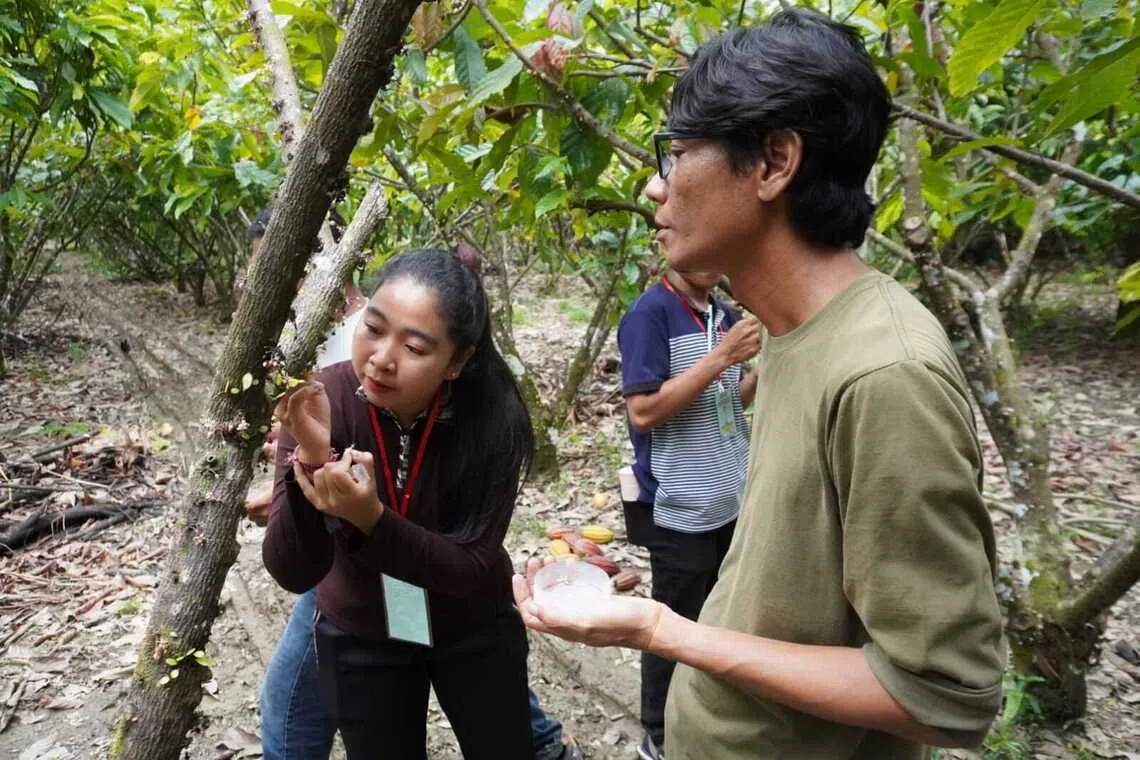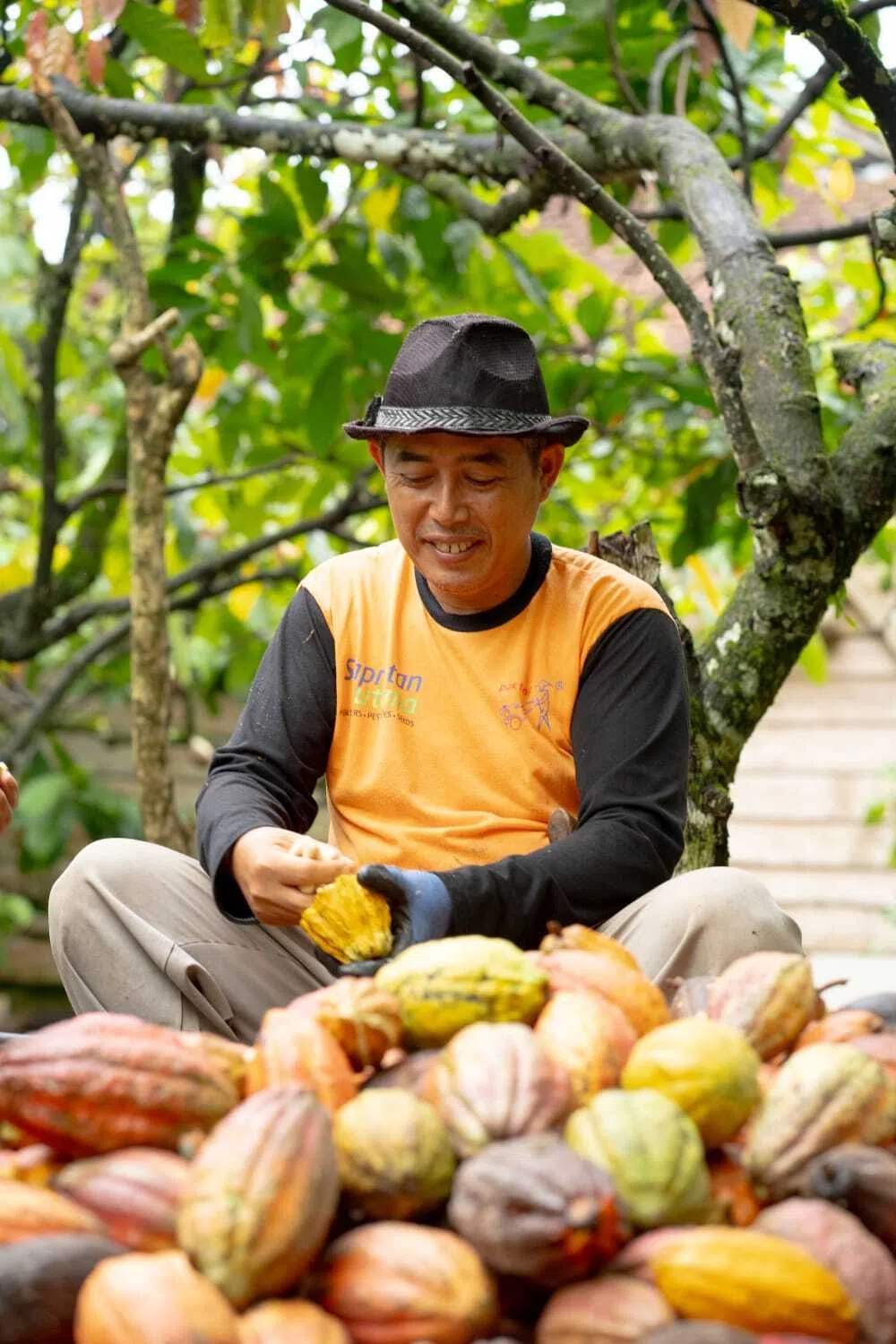Chocolate therapy: Indonesia’s cocoa farmers learn new ways to boost crop yields
Initiatives by candy maker Mars are also spurring interest among the younger generation

[SINGAPORE] The adoption of a supposedly superior cloned species was meant to help Indonesia’s cocoa farmers tackle declining yields caused by ageing trees, pests and climate pressures.
But the industry effort did not pay off, with supply on a continuous decline between 2013 and 2023.
Across that timeframe, regional cocoa bean production declined to less than 300,000 tonnes from about 485,000 tonnes, going by estimates from the Cocoa Association of Asia.
Over the same decade, the annual output of cocoa beans from Indonesia – Asia’s largest producer – fell from about 410,000 tonnes to roughly 180,000 tonnes. The country was once the world’s third-largest cocoa producer, and has since slipped to seventh place.
While multiple factors are at play in the decline, research initiated by Mars Wrigley seven years ago pointed to the supposedly superior cocoa cloning practice as being the culprit instead.
The candy maker’s Asia cocoa director, Choo Fay Fay, said that in some areas, farmers were “relying heavily” on a single cocoa clone. “As a result, this method did not bear fruit, as it prevented cross-pollination from happening.”
Choo added: “It is human nature to want good things, after all.” That clone was supposed to yield better-quality cocoa beans, which naturally led farmers to focus on planting only that variant.
The falling output has significant implications for the cocoa value chain. A report by US food corporation Cargill showed it takes about 400 cocoa beans to make a pound (0.45 kg) of chocolate.

As part of a collective effort to spur the crop’s regeneration, Mars joined hands with Indonesia’s government agencies, industry associations and other partners in the cocoa value chain.
Through Mars’ initiatives, farmers were taught that cocoa – unlike palm oil – could be grown with other crops such as banana and avocado; this method could aid soil regeneration as well.
Choo added that multiple cropping also ensures that farmers have income throughout the year, reducing their dependence on just one crop.
Modern cocoa system
Mars’ vision is to help contribute to a modern cocoa system driven by science, technology and innovation.
The average farm produces 0.5 to 0.6 tonnes of cocoa a hectare. Choo said this could go up to 1.2 to 1.5 tonnes a hectare with the right clones and good agricultural practices, allowing farmers to achieve a living income with other crops grown in agroforestry.
Farmer Asep Ruhli Hakim can attest to that. Before joining Mars’ training in business and agronomy – the science of soil management and crop production – he did not know how to prune or fertilise his plants properly.
“I was just farming cocoa the way I thought was right, without knowing the good practices that could actually improve my harvest,” he said.
Before the programme, his average net income from selling dried cocoa beans was about 2.5 million rupiah (S$195) a month. “Back then, I was also confused about what other agribusiness I could try, because I was so dependent on cocoa.”
Now, his monthly income has trebled to 7.5 million rupiah from selling wet beans to Mars’ factory, though his farm spans just four-fifths of a hectare. “During peak harvest, (the amount earned) can be even higher,” he said.
Another farmer, Suwardi, also started a cocoa nursery business with an initial capacity of 3,000 seedlings after joining Mars’ initiatives.
“Over time, it grew to 60,000 seedlings. Of course, seedling prices depend on cocoa bean prices and farmer demand. When the price was 5,000 rupiah per seedling, I earned around seven million rupiah per month,” he said.
“As prices and demand increased, that grew to 10 million to 15 million rupiah per month.”
Through its cocoa farming research programmes, Mars is looking at making the crop easier and more sustainable to grow.
Major challenges such as pests and diseases – which can cause up to 40 per cent crop losses – are being tackled by selecting and developing clones that are more resistant. Choo said Mars is “increasing the resilience of cocoa plants to environmental extremes, like heavy rainfall and drought”.
She added that Mars is also “working to reduce the labour required for cocoa farming through improved mechanisation and smarter field design”, so that it is easier for farmers to adopt new practices.
The next generation
These moves can also interest younger farmers in returning to the farms and managing them, Choo added. “Ultimately, by sustaining their livelihoods, we attract the next generation.”

Even as costs rose previously, Kalpesh Parmar, general manager of Mars Wrigley Asia, said the company decided against passing on the effect to consumers.
“We are thinking about the longer consumption runway. We are competing with other snacks. We want to… remain affordable in that consumption space,” he added.
“Hence, instead of a 50 g bar of Snickers, you see 25 g.”
Parmar noted that the company’s efforts have paid off, with cocoa bean production having stabilised over the past five years and showing signs of growth compared to a decade ago.
Choo said that higher prices and renewed farmer interest are driving the rise in output.
“With ongoing support through affordable quality inputs and agripreneur scaling – which empowers farmers to improve business skills and expand their operations – we are confident that farmers who embrace these practices will continue to earn a good livelihood,” she said.
“This also encourages the next generation to pursue cocoa farming as a viable and rewarding business. While today’s production levels are promising, their long-term sustainability will depend on maintaining this support and continued adoption of these innovative practices.”

Indeed, farmers such as Hakim are noticing renewed interest in cocoa farming from the younger generation. “In my village, many young people are going back to help their parents or even independently continue taking care of cocoa farms,” he said.
“I believe this is happening because of the rising cocoa bean prices. I see this as both an opportunity and a challenge. That’s why I encourage the young people in my village to take this chance by producing seedlings. It’s a very good way to learn and also to earn money through cocoa seedling businesses.”
Decoding Asia newsletter: your guide to navigating Asia in a new global order. Sign up here to get Decoding Asia newsletter. Delivered to your inbox. Free.
Copyright SPH Media. All rights reserved.



